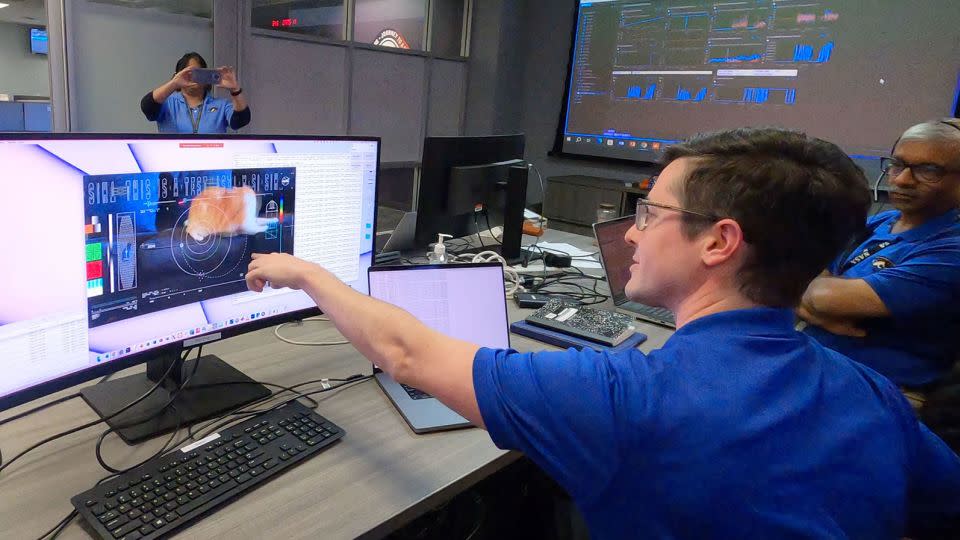Sign up for CNN’s Wonder Theory science newsletter. Explore the universe with news on exciting discoveries, scientific advances and more.
A laser communications experiment flying aboard NASA’s Psyche mission has sent video back to Earth from nearly 19 million miles (31 million kilometers) away – and the short clip features a cat named Taters. This is the first time NASA has streamed video from deep space using lasers.
In the ultra-high-definition video, the playful orange tabby cat chases, of all things, the fuzzy red dot from a laser pointer as it moves across a couch.
The cat video was transmitted to Earth from a flying laser transceiver as part of the Deep Space Optical Communications, or DSOC, experiment. The technology could one day be used to rapidly transmit data, imagery and video as humans push the boundaries of space exploration by heading to places like Mars.
The 15-second video was encoded in a near-infrared laser and transported from the Psyche spacecraft to the Hale Telescope at the California Institute of Technology’s Palomar Observatory. The video was downloaded at the observatory on December 11, and every frame was streamed live at NASA’s Jet Propulsion Laboratory in Pasadena, California.
At the time of transmission, the distance between the Psyche spacecraft and Hale was 80 times the distance between Earth and the moon. It only took 101 seconds for the laser to reach each Earth.
The laser can send data at 10 to 100 times the speed of traditional radio wave systems used by NASA on other missions. The technology demonstration was designed to be NASA’s most far-reaching experiment in high-bandwidth laser communications, testing the sending and receiving of data to and from Earth using invisible infrared lasers.
“This achievement demonstrates our commitment to advancing optical communications as a key element in meeting our future data transmission needs,” NASA Deputy Administrator Pam Melroy said in a statement. “Increasing our bandwidth is critical to achieving our future exploration and science goals, and we look forward to the continued advancement of this technology and the transformation of how we communicate during future interplanetary missions.”
Laser communication in deep space
Launched in mid-October, the Psyche mission is currently on its way to get humanity’s first glimpse of a metal asteroid between the orbits of Mars and Jupiter. The spacecraft will spend the next six years traveling about 2.2 billion miles (3.6 billion kilometers) to reach its namesake, located in the outer part of the main asteroid belt.

But the Deep Space Optical Communications experiment is doing a mission of its own during the first two years of the trip.
“One of the goals is to demonstrate the ability to transmit broadband video over millions of miles. Nothing on Psyche generates video data, so we typically send packets of randomly generated test data,” Bill Klipstein, DSOC project manager at the Jet Propulsion Laboratory, said in a statement.
“But to make this momentous event even more memorable, we decided to work with designers at JPL to create a fun video, which captures the essence of the display as part of the Psyche mission.”
‘Everybody loves Taters’
The DSOC team collaborated with the creators at JPL’s in-house DesignLab when deciding what video they wanted to test throughout deep space.
The video, which was uploaded to DSOC before Psyche’s launch, includes a graphics overlay showing Psyche’s orbital path, the Palomar telescope dome and Taters’ color, breeding and heart rate.
“Despite transmitting from millions of miles away, it was able to send the video faster than most broadband internet connections,” Ryan Rogalin, head of DSOC receiver electronics at JPL, said in a statement.
“In fact, after receiving the video at Palomar, it was sent to JPL over the internet, and that connection was slower than the signal from deep space. JPL’s DesignLab did a great job helping us showcase this technology—everyone loves Taters.”
Aside from the widespread popularity of cat videos and memes, the decision to include a cat video for the DSOC milestone is also a nod to broadcast history. A Felix the Cat cartoon statue was used in television test broadcast transmissions beginning in 1928, according to NASA.
A big milestone
The laser experiment’s latest successful test comes after DSOC’s Nov. 14 milestone of what it called a “first light,” in which engineers managed to send and receive its first data. Since then, the technology demonstration has only improved, showing capabilities such as the improved pointing accuracy so necessary when sending laser messages from space to Earth.
The laser’s fast downlink data speeds are comparable to broadband internet, and the DSOC team recently downloaded 1.3 terabits of data in a single evening—comparable to the 1.2 terabits NASA’s Magellan mission returned to Venus over four years in the 1990s.
“When we reached the first light, we were excited, but also cautious. This is new technology, and we are testing how it works,” Ken Andrews, head of project flight operations at JPL, said in a statement. “But now, with the help of our colleagues Psyche, we are getting used to working with the system and we can lock into the spacecraft and land terminals longer than we could before. We’re learning something new with every checkout.”
For more CNN news and newsletters create an account at CNN.com